MENU
The Electronic Scholarly Publishing Project: Providing access to classic scientific papers and other scholarly materials, since 1993. More About: ESP | OUR CONTENT | THIS WEBSITE | WHAT'S NEW | WHAT'S HOT
Comparative Timelines
The ESP Timeline (one of the site's most popular features) has been completely updated to allow the user to select (using the timeline controls above each column) different topics for the left and right sides of the display.
Select:
New Left Column
New Left Column
Dates
Decade
New Right Column
New Right Column
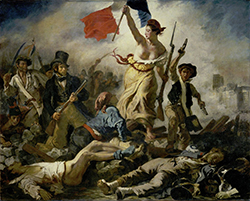 Painting by Eugène Delacroix: Liberty Leading the People (French: La Liberté guidant le peuple) commemorates the July Revolution of 1830, which toppled King Charles X of France. A woman personifying the concept and the Goddess of Liberty leads the people forward over a barricade and the bodies of the fallen, holding the flag of the French Revolution — the tricolour flag, which remains France's national flag — in one hand and brandishing a bayonetted musket with the other. The figure of Liberty is also viewed as a symbol of France and the French Republic known as Marianne. By the time Delacroix painted Liberty Leading the People, he was already the acknowledged leader of the Romantic school in French painting.
Painting by Eugène Delacroix: Liberty Leading the People (French: La Liberté guidant le peuple) commemorates the July Revolution of 1830, which toppled King Charles X of France. A woman personifying the concept and the Goddess of Liberty leads the people forward over a barricade and the bodies of the fallen, holding the flag of the French Revolution — the tricolour flag, which remains France's national flag — in one hand and brandishing a bayonetted musket with the other. The figure of Liberty is also viewed as a symbol of France and the French Republic known as Marianne. By the time Delacroix painted Liberty Leading the People, he was already the acknowledged leader of the Romantic school in French painting.
1830
(no entry for this year)
(no entry for this year)
1831
(no entry for this year)
(no entry for this year)
1832
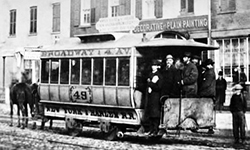 In November, the New York and Harlem Railroad begins service, and heralds the start of rapid mass transit in New York City. Two horse-drawn rail cars operate every 15 minutes between 14th Street and Prince Street, along the Bowery. The fare is 25 cents.
In November, the New York and Harlem Railroad begins service, and heralds the start of rapid mass transit in New York City. Two horse-drawn rail cars operate every 15 minutes between 14th Street and Prince Street, along the Bowery. The fare is 25 cents.
(no entry for this year)
1833
Ada Lovelace Meets Charles Babbage
(no entry for this year)
1834
 Hércules Florence, a French-Brazilian painter and the isolate inventor of photography in Brazil, coined the word photographie for his technique, at least four years before John Herschel coined the English word photography.
Hércules Florence, a French-Brazilian painter and the isolate inventor of photography in Brazil, coined the word photographie for his technique, at least four years before John Herschel coined the English word photography.
 Charles Babbage invents the "analytical engine" — the forerunner of the modern computer.
Charles Babbage invents the "analytical engine" — the forerunner of the modern computer.
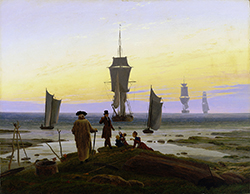 Painting by Caspar David Friedrich: The Stages of Life (German: Die Lebensstufen) is an allegorical oil painting completed just five years before his death. This picture, like many of his works, forms a meditation both on his own mortality and on the transience of life. The painting is set on a sea shore and shows in the foreground an aged man with his back turned to the viewer, walking towards two adults and two children on a hilltop overlooking a harbour. The figures are echoed by five ships shown in the harbour, each at a different distance from the shore, an allegorical reference to the different stages of human life, to the end of a journey, to the closeness of death. The figures have been identified as Friedrich and his family. The aged man is the artist himself, the small boy is his young son Gustav Adolf, the young girl is his daughter Agnes Adelheid, the older girl is his daughter Emma, and the man in the top hat is his nephew Johann Heinrich.}The Stages of Life (German: Die Lebensstufen) is an allegorical oil painting of 1835 by the German Romantic landscape painter Caspar David Friedrich. Completed just five years before his death, this picture, like many of his works, forms a meditation both on his own mortality and on the transience of life. The painting is set on a sea shore and shows in the foreground an aged man with his back turned to the viewer, walking towards two adults and two children on a hilltop overlooking a harbour. The figures are echoed by five ships shown in the harbour, each at a different distance from the shore, an allegorical reference to the different stages of human life, to the end of a journey, to the closeness of death. The figures have been identified as Friedrich and his family. The aged man is the artist himself, the small boy is his young son Gustav Adolf, the young girl is his daughter Agnes Adelheid, the older girl is his daughter Emma, and the man in the top hat is his nephew Johann Heinrich.
Painting by Caspar David Friedrich: The Stages of Life (German: Die Lebensstufen) is an allegorical oil painting completed just five years before his death. This picture, like many of his works, forms a meditation both on his own mortality and on the transience of life. The painting is set on a sea shore and shows in the foreground an aged man with his back turned to the viewer, walking towards two adults and two children on a hilltop overlooking a harbour. The figures are echoed by five ships shown in the harbour, each at a different distance from the shore, an allegorical reference to the different stages of human life, to the end of a journey, to the closeness of death. The figures have been identified as Friedrich and his family. The aged man is the artist himself, the small boy is his young son Gustav Adolf, the young girl is his daughter Agnes Adelheid, the older girl is his daughter Emma, and the man in the top hat is his nephew Johann Heinrich.}The Stages of Life (German: Die Lebensstufen) is an allegorical oil painting of 1835 by the German Romantic landscape painter Caspar David Friedrich. Completed just five years before his death, this picture, like many of his works, forms a meditation both on his own mortality and on the transience of life. The painting is set on a sea shore and shows in the foreground an aged man with his back turned to the viewer, walking towards two adults and two children on a hilltop overlooking a harbour. The figures are echoed by five ships shown in the harbour, each at a different distance from the shore, an allegorical reference to the different stages of human life, to the end of a journey, to the closeness of death. The figures have been identified as Friedrich and his family. The aged man is the artist himself, the small boy is his young son Gustav Adolf, the young girl is his daughter Agnes Adelheid, the older girl is his daughter Emma, and the man in the top hat is his nephew Johann Heinrich.
1835
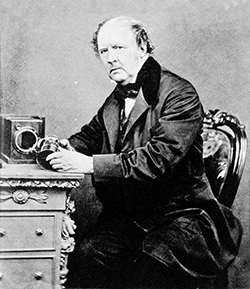 Henry Fox Talbot produces durable silver chloride camera negatives on paper and conceives the two-step negative-positive procedure used in most non-electronic photography up to the present.
Henry Fox Talbot produces durable silver chloride camera negatives on paper and conceives the two-step negative-positive procedure used in most non-electronic photography up to the present.
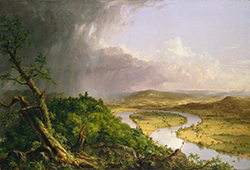 Painting by : View from Mount Holyoke, Northampton, Massachusetts, after a Thunderstorm, commonly known as The Oxbow, is a seminal landscape painting by Thomas Cole, founder of the Hudson River School. The painting depicts a Romantic panorama of the Connecticut River Valley just after a thunderstorm. It has been interpreted as a confrontation between wilderness and civilization.
Painting by : View from Mount Holyoke, Northampton, Massachusetts, after a Thunderstorm, commonly known as The Oxbow, is a seminal landscape painting by Thomas Cole, founder of the Hudson River School. The painting depicts a Romantic panorama of the Connecticut River Valley just after a thunderstorm. It has been interpreted as a confrontation between wilderness and civilization.
1836
Alonzo D. Phillips, a shoemaker from Springfield, Massachusetts, patents the phosphorous match.
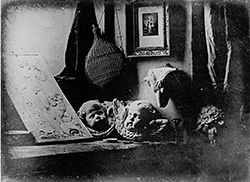 Daguerreotype by Louis Daguerre: Still life with plaster casts is the earliest, reliably dated daguerreotype.
Daguerreotype by Louis Daguerre: Still life with plaster casts is the earliest, reliably dated daguerreotype.
1837
Charles Babbage published a paper describing a mechanical computer that is now known as the Analytical Engine
 Samuel F. B. Morse sends his first message by electric telegraph — "What hath God wrought!" — on an experimental line between Washington DC and Baltimore, Maryland.
Samuel F. B. Morse sends his first message by electric telegraph — "What hath God wrought!" — on an experimental line between Washington DC and Baltimore, Maryland.
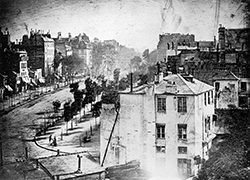 Daguerreotype by Louis Daguerre: The earliest reliably dated photograph of people, taken one spring morning in 1838 from the window of the Diorama, where Daguerre lived and worked. It bears the caption huit heure du matin (8 a.m.). Though it shows the busy Boulevard du Temple, the long exposure time (about ten or twelve minutes) meant that moving traffic cannot be seen; however, the bootblack and his customer at lower left remained still long enough to be distinctly visible. The building signage at the upper left shows that the image is laterally (left-right) reversed, as were most daguerreotypes.
Daguerreotype by Louis Daguerre: The earliest reliably dated photograph of people, taken one spring morning in 1838 from the window of the Diorama, where Daguerre lived and worked. It bears the caption huit heure du matin (8 a.m.). Though it shows the busy Boulevard du Temple, the long exposure time (about ten or twelve minutes) meant that moving traffic cannot be seen; however, the bootblack and his customer at lower left remained still long enough to be distinctly visible. The building signage at the upper left shows that the image is laterally (left-right) reversed, as were most daguerreotypes.
1838
The S.S. Sirius and the S. S. Great Western are the first ships powered entirely by steam to cross the Atlantic. Both ships are designed by engineer Isambard Kingdom Brunel (1806-1859).
(no entry for this year)
1839
 Louis-Jacques-Mand Daguerre perfects and presents the daguerreotype process as the first publicly available photographic process (which for nearly twenty years was also the one most commonly used). To make the image, a daguerreotypist would polish a sheet of silver-plated copper to a mirror finish, treat it with fumes that made its surface light sensitive, expose it in a camera for as long as was judged to be necessary, which could be as little as a few seconds for brightly sunlit subjects or much longer with less intense lighting; make the resulting latent image on it visible by fuming it with mercury vapor; remove its sensitivity to light by liquid chemical treatment, rinse and dry it, then seal the easily marred result behind glass in a protective enclosure.
Louis-Jacques-Mand Daguerre perfects and presents the daguerreotype process as the first publicly available photographic process (which for nearly twenty years was also the one most commonly used). To make the image, a daguerreotypist would polish a sheet of silver-plated copper to a mirror finish, treat it with fumes that made its surface light sensitive, expose it in a camera for as long as was judged to be necessary, which could be as little as a few seconds for brightly sunlit subjects or much longer with less intense lighting; make the resulting latent image on it visible by fuming it with mercury vapor; remove its sensitivity to light by liquid chemical treatment, rinse and dry it, then seal the easily marred result behind glass in a protective enclosure.
 Henry Fox Talbot publicly introduces the paper-based process he worked out in 1835, calling it "photogenic drawing", but it requires much longer exposures than the daguerreotype and the results are not as clear and detailed.
Henry Fox Talbot publicly introduces the paper-based process he worked out in 1835, calling it "photogenic drawing", but it requires much longer exposures than the daguerreotype and the results are not as clear and detailed.
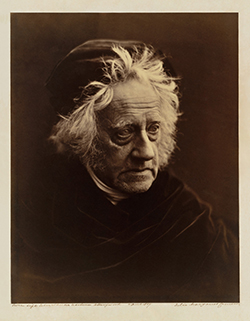 John Herschel introduces hyposulfite of soda (now known as sodium thiosulfate but still nicknamed "hypo") as a highly effective fixer for all silver-based processes. He also makes the first glass negative.
John Herschel introduces hyposulfite of soda (now known as sodium thiosulfate but still nicknamed "hypo") as a highly effective fixer for all silver-based processes. He also makes the first glass negative.
 Sarah Anne Bright creates a series of photograms, six of which are known to still exist. These are the earliest surviving photographic images created by a woman.
Sarah Anne Bright creates a series of photograms, six of which are known to still exist. These are the earliest surviving photographic images created by a woman.
 Although a bicycle consisting of a frame and wheels has existed for years, blacksmith Kirkpatrick MacMillan (1813-1878), introduces the first bicycle in its modern form, with brakes and pedals. The bike has iron tires and weighs nearly 60 pounds.
Although a bicycle consisting of a frame and wheels has existed for years, blacksmith Kirkpatrick MacMillan (1813-1878), introduces the first bicycle in its modern form, with brakes and pedals. The bike has iron tires and weighs nearly 60 pounds.
 Inventor Erastus Brigham Bigelow (1814-1879) introduces the power loom in Massachusetts.
Inventor Erastus Brigham Bigelow (1814-1879) introduces the power loom in Massachusetts.
 The first electric clock is built by physicist Carl August Steinheil (1801-1870).
The first electric clock is built by physicist Carl August Steinheil (1801-1870).
ESP Quick Facts
ESP Origins
In the early 1990's, Robert Robbins was a faculty member at Johns Hopkins, where he directed the informatics core of GDB — the human gene-mapping database of the international human genome project. To share papers with colleagues around the world, he set up a small paper-sharing section on his personal web page. This small project evolved into The Electronic Scholarly Publishing Project.
ESP Support
In 1995, Robbins became the VP/IT of the Fred Hutchinson Cancer Research Center in Seattle, WA. Soon after arriving in Seattle, Robbins secured funding, through the ELSI component of the US Human Genome Project, to create the original ESP.ORG web site, with the formal goal of providing free, world-wide access to the literature of classical genetics.
ESP Rationale
Although the methods of molecular biology can seem almost magical to the uninitiated, the original techniques of classical genetics are readily appreciated by one and all: cross individuals that differ in some inherited trait, collect all of the progeny, score their attributes, and propose mechanisms to explain the patterns of inheritance observed.
ESP Goal
In reading the early works of classical genetics, one is drawn, almost inexorably, into ever more complex models, until molecular explanations begin to seem both necessary and natural. At that point, the tools for understanding genome research are at hand. Assisting readers reach this point was the original goal of The Electronic Scholarly Publishing Project.
ESP Usage
Usage of the site grew rapidly and has remained high. Faculty began to use the site for their assigned readings. Other on-line publishers, ranging from The New York Times to Nature referenced ESP materials in their own publications. Nobel laureates (e.g., Joshua Lederberg) regularly used the site and even wrote to suggest changes and improvements.
ESP Content
When the site began, no journals were making their early content available in digital format. As a result, ESP was obliged to digitize classic literature before it could be made available. For many important papers — such as Mendel's original paper or the first genetic map — ESP had to produce entirely new typeset versions of the works, if they were to be available in a high-quality format.
ESP Help
Early support from the DOE component of the Human Genome Project was critically important for getting the ESP project on a firm foundation. Since that funding ended (nearly 20 years ago), the project has been operated as a purely volunteer effort. Anyone wishing to assist in these efforts should send an email to Robbins.
ESP Plans
With the development of methods for adding typeset side notes to PDF files, the ESP project now plans to add annotated versions of some classical papers to its holdings. We also plan to add new reference and pedagogical material. We have already started providing regularly updated, comprehensive bibliographies to the ESP.ORG site.
ESP Picks from Around the Web (updated 06 MAR 2017 )
Old Science

Weird Science

Treating Disease with Fecal Transplantation
Fossils of miniature humans (hobbits) discovered in Indonesia

Dinosaur tail, complete with feathers, found preserved in amber.
Astronomy

Mysterious fast radio burst (FRB) detected in the distant universe.